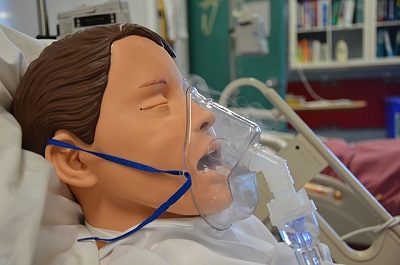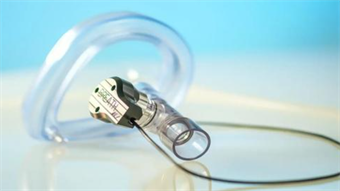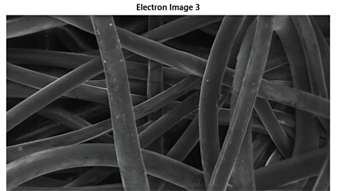Here's how a nebulizer works to treat respiratory ailments
Engineering360 News Desk | March 12, 2020As health professionals around the world work to treat a range of respiratory ailments, including the novel coronavirus known as Covid-19, a critical piece of medical equipment is a nebulizer.
These devices aerosolize medications and deliver them as a mist to a patient's lungs. They represent a common means of drug delivery for people with respiratory illnesses. Here is how they work.
 A nebulizer is used to administer drug treatments to a patient suffering from a variety of respiratory ailments. Source: Wikimedia Commons by British Columbia Institute of Technology Medical prescriptions and compounds that need to be applied to a patient's lungs are atomized by a nebulizer into an aerosol suspension.
A nebulizer is used to administer drug treatments to a patient suffering from a variety of respiratory ailments. Source: Wikimedia Commons by British Columbia Institute of Technology Medical prescriptions and compounds that need to be applied to a patient's lungs are atomized by a nebulizer into an aerosol suspension.
Droplets of the medication are less than 10 micrometers in diameter so they are comfortably inhaled by the patient to the lungs, not the mouth or throat. Applying medicine to the respiratory tract hastens its benefits and reduces side effects.
To use, a patient or care aide fills the nebulizer reservoir or cup with the correct dosage. Atomization is completed by manual power, a compressor, a piezoelectric element or ultrasonic mechanisms.
The patient is connected to the nebulizer with a mouthpiece or face mask that may be on an extension hose. The patient slowly takes deep breaths through the machine for anywhere from 5 to 25 minutes. The machine supplies the medicated aerosol in ambient gas.
Types
Many types of nebulizers are commonly used in medical settings. These include the following:
Soft mist inhaler: A user winds a spring to build pressure in the device, which once released forces a metered dose out of nozzles that atomize the liquid.
Human powered nebulizer (HPN): Pedal-driven pistons atomize a liquid and supply it to the patient's lungs.
Vibrating mesh: There are two types of vibrating mesh nebulizers. In active vibrating mesh nebulizers, a piezoelectric element vibrates a precision mesh plate that is in contact with the liquid and creates a micropump action that atomizes the liquid. Passive types of this device use an ultrasonic horn connected to a piezo element for nebulization.
Breath-actuated nebulizers: The nebulizer only aerosolizes medication when the patient inhales, meaning none of the aerosol is lost through the nebulizer or exhalation valve. These nebulizers can be manual, mechanical or electronic.
Jet nebulizer: A compressor flows air or oxygen through the liquid to generate an aerosol that can be inhaled.
Ultrasonic nebulizer: A piezoelectric crystal at high frequency (1 to 3 MHz) creates the aerosol.
(Read here to learn more about nebulizer specifications and product features.)




